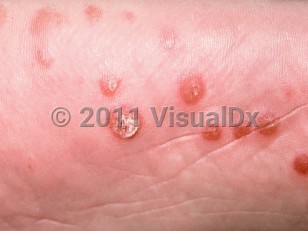Reactive arthritis - Anogenital in
See also in: Overview,Nail and Distal DigitAlerts and Notices
Important News & Links
Synopsis

Reactive arthritis (ReA, previously called Reiter syndrome) is a type of spondyloarthropathy that occurs after gastrointestinal or genitourinary infections. It is called "reactive" as opposed to "septic" because the arthritis is sterile; bacteria provoke the arthritis without directly invading the joint space.
ReA was initially described after infections with specific bacteria: Chlamydia trachomatis, Shigella, Salmonella, Yersinia, and Campylobacter. However, recent studies have implicated Clostridioides difficile, Giardia, and other atypical infections as triggers for ReA.
As in other spondyloarthropathies, ReA is associated with HLA-B27. It occurs most commonly in men ages 20-40. It can be especially common in patients with human immunodeficiency virus (HIV) infection, and they present with more severe symptoms. It is unclear how infections trigger the disease.
Patients with ReA usually become symptomatic 1-4 weeks after a gastrointestinal or genitourinary infection. ReA usually presents as an acutely painful oligoarthritis (fewer than 5 joints), usually of the lower extremities. Patients can also complain of stiffness and pain of the lower back. Enthesitis is especially common, and dactylitis (sausage digits) can also be seen. Patients occasionally have systemic features, including fever, weight loss, and fatigue. Only a minority of patients present with the "classic" triad of arthritis, urethritis, and conjunctivitis. Patients with ReA can develop extra-articular manifestations including uveitis and inflammatory bowel disease.
Chlamydia trachomatis is the most common trigger. Some studies suggest that up to 8% of patients with chlamydial infections develop ReA. However, because these infections are often asymptomatic, the diagnosis of ReA is often missed. In children, the condition is rare and is most commonly triggered by gastrointestinal infections.
For most patients, ReA is a self-limited disease, and they recover completely within 2-6 months. A chronic arthritis may persist in a minority, usually in association with HLA-B27 phenotype. Other patients can develop recurrent episodes of ReA after encountering the same organism.
ReA was initially described after infections with specific bacteria: Chlamydia trachomatis, Shigella, Salmonella, Yersinia, and Campylobacter. However, recent studies have implicated Clostridioides difficile, Giardia, and other atypical infections as triggers for ReA.
As in other spondyloarthropathies, ReA is associated with HLA-B27. It occurs most commonly in men ages 20-40. It can be especially common in patients with human immunodeficiency virus (HIV) infection, and they present with more severe symptoms. It is unclear how infections trigger the disease.
Patients with ReA usually become symptomatic 1-4 weeks after a gastrointestinal or genitourinary infection. ReA usually presents as an acutely painful oligoarthritis (fewer than 5 joints), usually of the lower extremities. Patients can also complain of stiffness and pain of the lower back. Enthesitis is especially common, and dactylitis (sausage digits) can also be seen. Patients occasionally have systemic features, including fever, weight loss, and fatigue. Only a minority of patients present with the "classic" triad of arthritis, urethritis, and conjunctivitis. Patients with ReA can develop extra-articular manifestations including uveitis and inflammatory bowel disease.
Chlamydia trachomatis is the most common trigger. Some studies suggest that up to 8% of patients with chlamydial infections develop ReA. However, because these infections are often asymptomatic, the diagnosis of ReA is often missed. In children, the condition is rare and is most commonly triggered by gastrointestinal infections.
For most patients, ReA is a self-limited disease, and they recover completely within 2-6 months. A chronic arthritis may persist in a minority, usually in association with HLA-B27 phenotype. Other patients can develop recurrent episodes of ReA after encountering the same organism.
Codes
ICD10CM:
M02.30 – Reiter's disease, unspecified site
SNOMEDCT:
67224007 – Reactive arthritis
M02.30 – Reiter's disease, unspecified site
SNOMEDCT:
67224007 – Reactive arthritis
Look For
Subscription Required
Diagnostic Pearls
Subscription Required
Differential Diagnosis & Pitfalls

To perform a comparison, select diagnoses from the classic differential
Subscription Required
Best Tests
Subscription Required
Management Pearls
Subscription Required
Therapy
Subscription Required
References
Subscription Required
Last Reviewed:02/05/2017
Last Updated:10/16/2022
Last Updated:10/16/2022
 Patient Information for Reactive arthritis - Anogenital in
Patient Information for Reactive arthritis - Anogenital in
Premium Feature
VisualDx Patient Handouts
Available in the Elite package
- Improve treatment compliance
- Reduce after-hours questions
- Increase patient engagement and satisfaction
- Written in clear, easy-to-understand language. No confusing jargon.
- Available in English and Spanish
- Print out or email directly to your patient
Upgrade Today

Reactive arthritis - Anogenital in
See also in: Overview,Nail and Distal Digit

